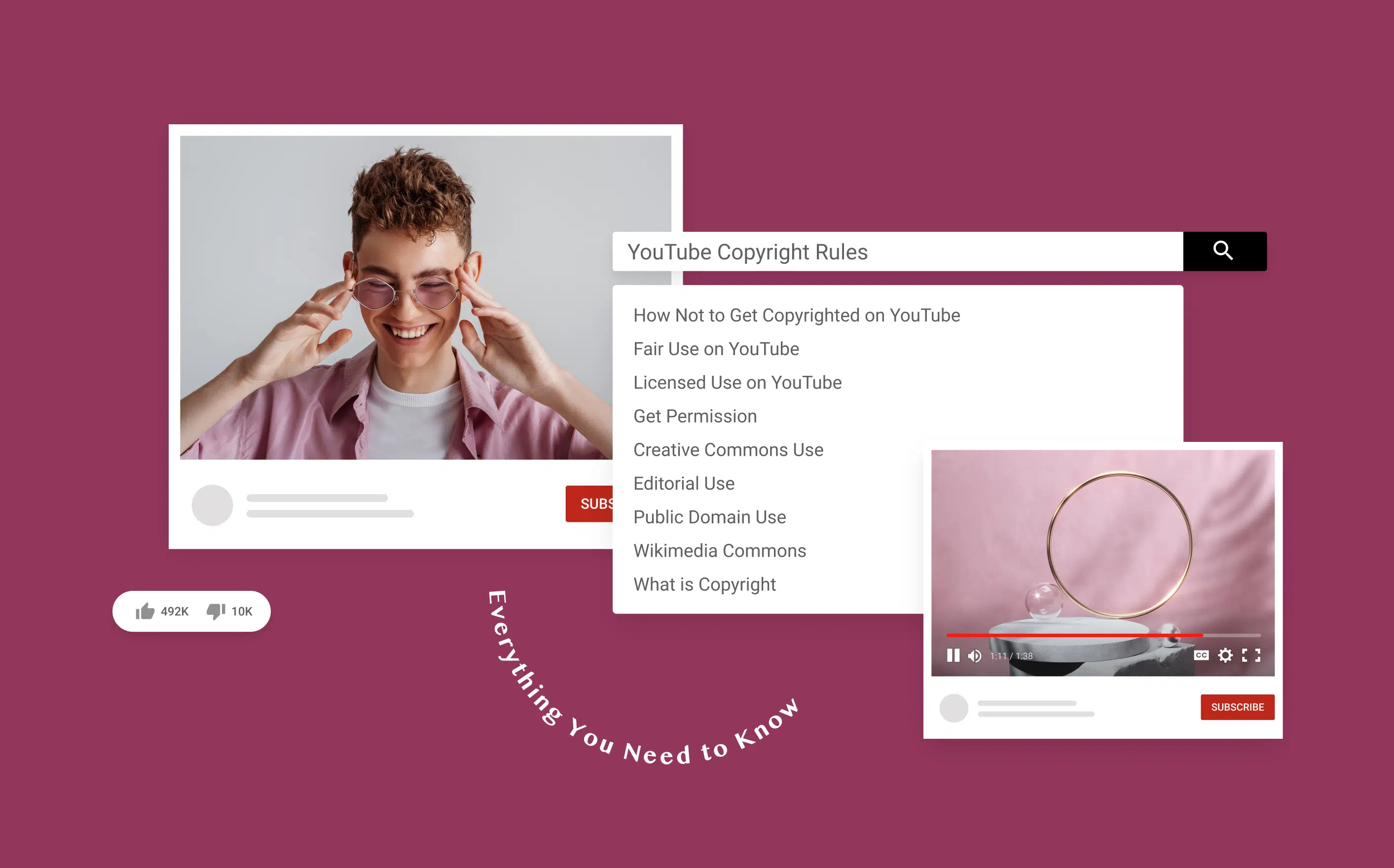
When someone infringes on copyright — whether it’s someone doing it to you or you doing it to someone else — there will be consequences. YouTube takes the breach seriously and will take down the infringing video. It also penalizes the offender with a strike. And as in baseball, if you get three strikes, you’re outta there! YouTube boots you and your channel if it gets to this point.
To ensure that it doesn’t happen to you, follow this advice:
Remember who owns the copyright
It’s fairly simple: If you created the video, the copyright belongs to you; if you upload content created by someone else, the copyright belongs to that person, and you better get their permission before you upload it it.
As soon as the work is created, so is the copyright, and since 1992, there’s no longer a renewal process. Copyright lives with the creator — and even lives on for a period after the death of the creator.
Attribution does not absolve a copyright violation
Some people steal other people’s work and claim it as their own, and that’s blatant infringement. But it’s no less of an offense when you use content and then add a line saying, “Created by so‐and‐so,” or “No copyright infringement intended,” or “All rights belong to their respective owners.” It’s still a breach that can earn a strike and a block of the video.
If you use someone else’s work in your video without that person’s permission, it doesn’t make it less of an offense just because you give the person credit. You’re still in violation because attributing the creator doesn’t absolve you if you don’t get permission.
Know the consequences
Two things can happen if you commit a copyright violation, and though they sound similar, they’re completely different:
-
Takedown notice: If someone spots content they’ve created being used without their permission, they can send YouTube a complaint. If it’s a breach, YouTube takes down the video and issues the offender a copyright strike.
-
Content ID match: Content ID is a system YouTube uses to automatically match content that violates copyright against the millions of videos uploaded every month to the site. For Content ID to work properly, copyright owners have to upload so‐called reference files — original versions of their work that prove they own the rights.
Normally, record labels, movie studios, or TV stations go through this process for all the work they publish, so individual artists don’t have to worry about it. Every new video uploaded to YouTube is checked against this huge library of reference files, and if there is a match, YouTube automatically files a copyright claim for the owner of the work.
No matter how a copyright violation may have been discovered, if you breach another content creator’s copyright, that creator is in a position to have YouTube take down your content. In the event of a mistake, you can send YouTube a notice saying that an error occurred, but you had better be darn sure about it. If the claim ends up being proven correct, or if you were untruthful in any way, you may find yourself in much bigger trouble, including legal action.
The profit motive is irrelevant
Some folks will say, “Hey, it’s all right if I use someone else’s content, because I’m not looking to make any money.” Say that before the judge and the verdict will still be “Guilty of copyright infringement!”
Whether you intend to make money from the video or you simply want to share your masterpiece with the world, it still doesn’t mean that you can violate copyright law. You need to get permission from the copyright holder.
Getting permission for using copyrighted material
Getting permission to use someone else’s copyrighted material is often well within the realm of the possible. A nicely written note explaining how you would use the content usually is enough for a rights holder to grant permission.
Just remember that it can get dicey, because sometimes permission comes with the caveat that you cannot monetize the overall video. That restriction can hurt big‐time if your intention is to quit your day job, but it may end up being a bittersweet solution if you’re merely looking to add flavor to your video.
Fair use is complicated
Albert Einstein never failed math, unicorns don’t exist, and fair use is anything but easy — or fair — to understand. Debunking the first two of these myths is easy. All right, maybe the first is, but when it comes to fair use, that’s a single‐horned horse of a different color.
Many misconceptions exist surrounding fair use, among them the notion that you can use anything you want as long as you don’t go beyond some arbitrary time constraint. But it’s much more complicated. In some editorial situations, you can use copyrighted material without permission, but you must fully understand those situations to avoid future trouble.
If you feel the need to exercise fair use, and the use is for nonprofit and educational purpose, here a few acceptable uses to consider:
-
Criticism: Reviewing a movie or some form of music makes it perfectly acceptable to use copyrighted material without permission, for example short clips on the work you critique.
-
Parody: If you’re poking fun at something, it’s acceptable to use content without first gaining permission.
-
Commentary: This one depends on how you use the material. If it’s used just enough to illustrate your point, it’s acceptable. For instance, gamers on YouTube often record themselves playing a new video game and offer funny observations. This is, within limits, fair use.
- Academic: If you’re creating educational content, it’s considered fair to use to reference other works in certain situations.
And now for the misconceptions:
-
You can use 40 seconds of anything: It’s completely untrue. You can’t use even 4 seconds if it doesn’t comply with the circumstances in the preceding list. As a best practice, use the least amount of copyrighted material to get your point across, and always credit the original copyright owner.
-
The notion that you can decide fair use for yourself: Fair use is complicated for many situations, so you may not be sure exactly what you’re allowed to do. The thing is, if you stretch the limits of fair use too far, and harm the original copyright owner’s ability to profit from their work, you can be sanctioned by YouTube. That’s why a copyright attorney should decide any serious question over fair use.
Don’t let copyright issues on YouTube lead to a strikeout
Three strikes and you’re out is a common understanding when playing baseball. But in baseball, you get another chance after another eight batters have had their try. YouTube doesn’t share this benevolence, so if they give you three strikes — especially for copyright issues — that means a lifetime ban from its partnership program.
That’s something you don’t want on your record; worse yet, once that happens to you, you won’t be able to recover any of your videos. So, you want to avoid getting strikes at all costs.
There are two types of YouTube strikes:
-
Community guideline strike: This type can result from a variety of causes, ranging from uploading objectionable content to having a misleading thumbnail or caption. You can learn more about these guidelines on YouTube’s Community Guidelines page.
-
Copyright strike: If some part of your video includes content from another creator and that creator did not grant you permission, you can get a copyright strike. You can appeal it or take down the video to avoid a possible strike.
Other things you should know:
-
Mandatory copyright school must be completed: After your first strike, YouTube requires that you take an online course and take a little quiz to be sure you’re up to speed on copyright regulations.
-
Strikes come down, eventually: As long as you haven’t struck out, community guideline strikes and copyright strikes disappear after 90 days from the time they’re issued. At that point, YouTube restores any channel privileges you lost while you waited out the strike. If you draw three community guideline strikes or three copyright strikes over a 90-day period, your YouTube channel will be terminated.
-
Your fate usually lies with the copyright holder: That person can decide whether the video you uploaded should be removed, flagged in certain regions, or even monetized. Yes, that’s right: Even though the video may contain only a small portion of the person’s material, they’re entitled to all monetization proceeds. They can even put ads on your video, if you haven’t added monetization.
Wipe the slate clean
If you get a copyright strike from YouTube and you’re positive that you’re in the right, go ahead and appeal the strike with a copyright counter-notification.
If you’re not sure whether you can win, maybe it’s better to wait it out until the strike expires. You see, after you appeal the strike, your personal information goes to the copyright holder and that person can possibly sue you for copyright infringement. If the situation gets to this level, you still can work out an agreement directly with the copyright holder and see whether they will file an appeal with YouTube on your behalf if you both agree that you were within your rights to use the copyrighted material. It’s worth a shot.
YouTube’s robots are good at finding copyright infringements
Whether intentional or inadvertent, sometimes the content of other creators gets used in a YouTube video. Sometimes the breach is noticed, and at other times it goes undetected by the original creator. But as YouTube continues to refine its copyright detection system, the system will find infringements more quickly than ever.
Part of those refinements to YouTube’s copyright detection system include sophisticated algorithms that scan every uploaded video and compare it to similar uploaded content, looking for matches with music, video, or pictures. It seems music gets detected the most. Even if it’s background music, you may get sanctioned. Usually, YouTube blocks the video, and you must submit a dispute form.
Copyright is not forever, but it’s forever enough for YouTube
Copyright lasts for 70 years past the death of the author; after that point, the copyrighted content enters the public domain. When that happens, the content is no longer protected by intellectual property laws, and anyone can use it without permission. Of course, for many people on YouTube, that content isn’t available to use without permission until we near the next century.
Of course, if the creator (or the creator’s heirs) files a copyright extension, they can hold on to the rights — that way, the video of your dog dressed as a spider can stay in the family for as long as possible.
[“source=dummies”]
